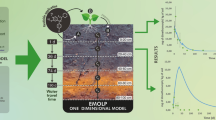Abstract.
Because the primary factor controlling the persistence of pesticides in soil is microbial transformation, its mathematical modelling deserves attention. Soil persistence and leaching models are very sensitive to the parameters governing sorption and degradation. As a first part of this paper, we will present currently used rate laws for pesticide degradation in soils, essentially based on first-order reaction kinetics. We will discuss how recent knowledge on pesticide microbiology and practical observations like accelerated and stimulated degradation can be included in the description of the degradation process. We discuss the influence of spatial variability and parameter uncertainty on the distribution of the model output. In the last part of the paper, we suggest methodological approaches for studying and describing temperature and moisture effects and for obtaining more realistic values for the first-order rate constant or other biokinetic parameters, which control persistence of pesticides in soils.
Similar content being viewed by others
Author information
Authors and Affiliations
Additional information
Electronic Publication
Rights and permissions
About this article
Cite this article
Soulas, G., Lagacherie, B. Modelling of microbial degradation of pesticides in soils. Biol Fertil Soils 33, 551–557 (2001). https://doi.org/10.1007/s003740100363
Received:
Issue Date:
DOI: https://doi.org/10.1007/s003740100363




